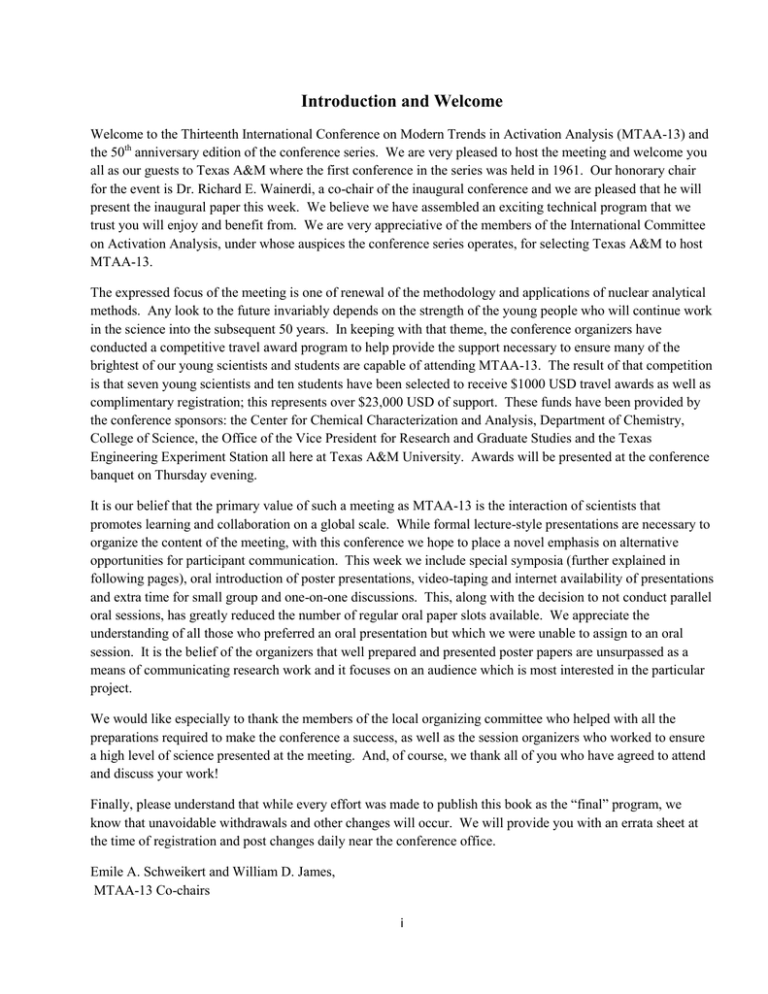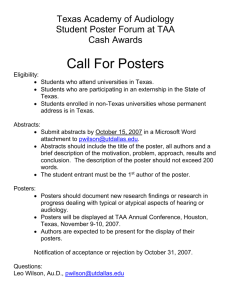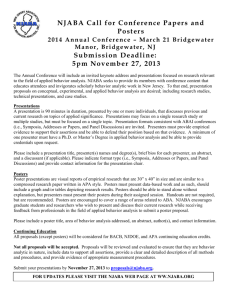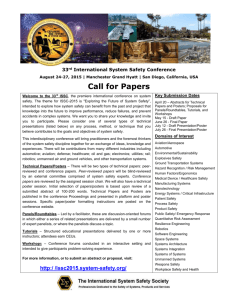Introduction and Welcome Welcome to the Thirteenth International
advertisement

Introduction and Welcome Welcome to the Thirteenth International Conference on Modern Trends in Activation Analysis (MTAA-13) and the 50th anniversary edition of the conference series. We are very pleased to host the meeting and welcome you all as our guests to Texas A&M where the first conference in the series was held in 1961. Our honorary chair for the event is Dr. Richard E. Wainerdi, a co-chair of the inaugural conference and we are pleased that he will present the inaugural paper this week. We believe we have assembled an exciting technical program that we trust you will enjoy and benefit from. We are very appreciative of the members of the International Committee on Activation Analysis, under whose auspices the conference series operates, for selecting Texas A&M to host MTAA-13. The expressed focus of the meeting is one of renewal of the methodology and applications of nuclear analytical methods. Any look to the future invariably depends on the strength of the young people who will continue work in the science into the subsequent 50 years. In keeping with that theme, the conference organizers have conducted a competitive travel award program to help provide the support necessary to ensure many of the brightest of our young scientists and students are capable of attending MTAA-13. The result of that competition is that seven young scientists and ten students have been selected to receive $1000 USD travel awards as well as complimentary registration; this represents over $23,000 USD of support. These funds have been provided by the conference sponsors: the Center for Chemical Characterization and Analysis, Department of Chemistry, College of Science, the Office of the Vice President for Research and Graduate Studies and the Texas Engineering Experiment Station all here at Texas A&M University. Awards will be presented at the conference banquet on Thursday evening. It is our belief that the primary value of such a meeting as MTAA-13 is the interaction of scientists that promotes learning and collaboration on a global scale. While formal lecture-style presentations are necessary to organize the content of the meeting, with this conference we hope to place a novel emphasis on alternative opportunities for participant communication. This week we include special symposia (further explained in following pages), oral introduction of poster presentations, video-taping and internet availability of presentations and extra time for small group and one-on-one discussions. This, along with the decision to not conduct parallel oral sessions, has greatly reduced the number of regular oral paper slots available. We appreciate the understanding of all those who preferred an oral presentation but which we were unable to assign to an oral session. It is the belief of the organizers that well prepared and presented poster papers are unsurpassed as a means of communicating research work and it focuses on an audience which is most interested in the particular project. We would like especially to thank the members of the local organizing committee who helped with all the preparations required to make the conference a success, as well as the session organizers who worked to ensure a high level of science presented at the meeting. And, of course, we thank all of you who have agreed to attend and discuss your work! Finally, please understand that while every effort was made to publish this book as the “final” program, we know that unavoidable withdrawals and other changes will occur. We will provide you with an errata sheet at the time of registration and post changes daily near the conference office. Emile A. Schweikert and William D. James, MTAA-13 Co-chairs i Conference Information Registration: On-site registration, as well as packet pickup for those who have preregistered online, will be: Sunday, March 13th: 4:00 to 6:00 p.m. preceding the Welcome Reception at the George Bush Presidential Library. Monday, March 14th – Wednesday, March 16th: 7:00 a.m. to 5:00 p.m. at the Interdisciplinary Life Science Building atrium lobby. Thursday, March 17th: 8:00 a.m. to 5 p.m. and Friday, March 18th: 7:00 a.m. to 10:00 a.m. at the Interdisciplinary Life Science Building atrium lobby. Conference Venues: The technical conference program will be conducted in the Interdisciplinary Life Science Building, Room 1105 auditorium, with poster presentations in the atrium lobby. Wireless internet is available throughout the building. The Welcome reception on Sunday evening will be in the George Bush Presidential Library, the Special Symposia and buffet dinner will be in the Hagler (Texas A&M Foundation) Center on Tuesday evening and the conference banquet on Thursday evening will be in the Clayton Williams Former Students Center. Fritz Grass Memorial Session: We mourn the recent passing of our colleague Professor Friedrich Grass, Atom Institute, Technical University of Vienna on September 29, 2010, but we want to celebrate his many scientific achievements through the incorporation of a memorial technical session in MTAA-13. This session, organized and chaired by Dr. Rolf Zeisler, will be conducted immediately after the conference opening and anniversary review. Two Hevesy Medal Presentations: MTAA-13 organizers are proud to host an unprecedented two George Hevesy award ceremonies and lectures. The ceremony for 2010 medal awardee, Professor Emeritus Darleane Hoffman, University of California at Berkeley will take place on Monday morning at 11:00 a.m. 2011 awardee Professor Peter Bode, Delft University of Technology will receive his award and present his lecture during the conference banquet on Thursday evening. Oral Sessions: All papers, unless otherwise noted, will be allotted 15 minutes for the presentation and 5 minutes for questions. These time limits will be strictly enforced to support our tightly packed schedule. All oral talks must utilize computer projection of Microsoft Powerpoint presentations. Speakers must submit their digital presentations the day prior to their talk at the speakers’ desk in the conference office (ILSB, room 1109). Obviously, speakers for Monday sessions should submit their presentations during registration hours before the conference convenes. Special Symposia: In order to encourage small group and one-on-one communication, MTAA-13 introduces the concept of hybrid special symposia. A few chosen speakers will make very brief oral presentations which are designed to add to the introductions of special topics by the symposia organizers which are to be presented earlier in the afternoon. Each oral presenter will also display an associated poster, along with other posters on the topic, in the symposium room. Half the 2-hour symposium time will be reserved for the orals and half for discussion around the posters. Three concurrent symposia will be conducted following a buffet dinner at the Hagler Center. ii Poster Sessions: There will be two general poster sessions. In addition, some posters will be displayed in association with the Special Symposia on Tuesday evening at the Hagler Center. Presenters for posters displayed during the Tuesday poster session (TUAMPA) will put up posters immediately following the Monday afternoon sessions. Oral introductions for the Tuesday session posters will be videotaped beginning at 5:30 p.m. on Monday evening. Presenters for posters displayed during the Thursday poster session (THAMPB) will put up posters from 7:00 to 7:30 a.m. on Thursday morning with video-taping following at 8:00 a.m. Posters presented in association with Special Symposia will be put up during the buffet dinner on Tuesday evening just prior to the symposia. No video-taping is planned for symposia posters. All posters will be removed at the conclusion of the poster session. Access to Wireless Network: Access to the wireless internet is controlled at Texas A&M University. Each participant wishing to use the wireless network will be issued a unique user identification to the TAMU-guest network along with a password. Please be advised that the University requires that each individual be issued separate IDs and they are monitored for illegal/inappropriate activity so account sharing is not allowed. Manuscripts and Manuscript Review: All papers presented at MTAA-13, whether oral or poster, are welcome as submissions to the conference proceedings which will be published in the Journal of Radioanalytical and Nuclear Chemistry. Manuscript submissions must be performed by electronic uploading via the conference website and associated links for that purpose by the deadline as described on the website. Reviewers for peerreview will be selected by our Publication Committee from attendees at the conference and manuscripts for review will be distributed by email and reviews submitted electronically. Please be prepared to review assigned papers before May 1, 2011. Since the papers will be distributed as much as possible before/during the conference, we encourage reviewers to complete as many reviews as possible before the end of the conference. This will greatly facilitate timely publication of the transactions. Questions regarding publication may be forwarded to our Publication Chair, Dr. Rolf Zeisler at mtaa13@tamu.edu. Social Program and Meals Provided: Conference participants and guests are encouraged to attend the social events which are included in the registration fee and guest package. These include: Welcome Reception – Sunday evening, March 13th, 6:00 to 8:00 p.m. at the George Bush Presidential Library. A self-guided tour of the library is included. Houston Livestock Show and Rodeo – This is the largest rodeo in the world with over 2 million visitors annually. The RODEOHOUSTON BP Super Series Semifinal will begin at 6:45 p.m. on Wednesday evening, March 16th with the top rodeo cowboys competing for more than $1.5 million in prize money. The evening will be capped off with a performance by Miranda Lambert, a native Texan and rising star in American Country Music. Lambert began performing at 17 years old. By 25, she already has received 11 Academy of Country Music awards and 7 nominations for awards in 2011. In 2010, Lambert won Album of the Year and Female Vocalist of the Year. She is known for her high energy iii shows and classic country style. We will travel to Houston by bus Wednesday afternoon; thereafter you will be on your own to explore the fairgrounds, purchase your own dinner from numerous venders and attend the rodeo and concert. Conference Banquet – Thursday evening, March 17th, 6:30 to 8:30 p.m. at the Clayton Williams Former Students Center. The 2011 Hevesy Medal ceremony will take place and the Hevesy lecture will serve as the after-dinner address. Conference participants will also be provided with daily lunch boxes and coffee breaks each morning and afternoon. In addition, there will be a buffet dinner with cash bar provided at the Hagler Center (Texas A&M Foundation) preceding the special symposia. Guests will have their own activities on Monday and Tuesday with a trip to our local winery, Messina Hoff, and a tour of local western manufacturing of boots, saddles and ten-gallon hats in downtown Bryan. Each activity is followed with an included lunch. Local Organizing Committee: Richard E. Wainerdi, Honorary Chairman Emile Schweikert, Co-chair Dennis James, Co-chair Lee Peddicord, Texas A&M University Sheldon Landsberger, University of Texas Ken Ellis, Baylor College of Medicine Dan Reece, Texas A&M University Rolf Zeisler, NIST Ron Carter, Texas A&M University Mary Cearley, Texas A&M University International Committee of Activation Analysis (ICAA) Peter Bode, The Netherlands Chai Zhifang, China Amares Chatt, Canada Frans De Corte, Belgium Mitrsuru Ebihara, Japan Elisabete A. De Nadai Fernandes, Brazil Maria do Carmo Freitas, Portugal Marina Frontasyeva, Russia Robert R. Greenberg, USA Venkatesh Iyengar, USA William D. James, USA Greg Kennedy, Canada Vladimir Kolotov, Russia Jan Kucera, Czech Rebublic Susan J. Parry, United Kingdom Zsolt Revay, Hungary Matthias Rossbach, Germany Borut Smodis, Slovenia Nicholas M. Spyrou, United Kingdom Chushiro Yonezawa, Japan Rolf Zeisler, USA iv Sponsorship: MTAA-13 is conducted with cooperation of the American Nuclear Society (ANS) and the International Atomic Energy Agency (IAEA). Those organizations providing financial support include: Texas A&M University The Center for Chemical Characterization and Analysis Office of the Vice President for Research and Graduate Studies Texas Engineering Experiment Station College of Science Department of Chemistry Canberra Industries Ortec (Advanced Measurement Technology) v




